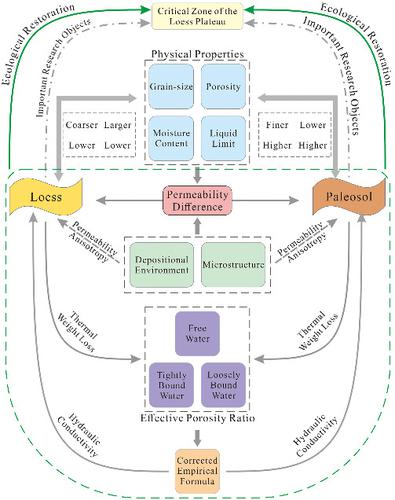当前位置:
X-MOL 学术
›
Earth Surf.Process. Land.
›
论文详情
Our official English website, www.x-mol.net, welcomes your
feedback! (Note: you will need to create a separate account there.)
Seepage mechanisms and permeability differences between loess and paleosols in the critical zone of the Loess Plateau
Earth Surface Processes and Landforms ( IF 2.8 ) Pub Date : 2021-04-29 , DOI: 10.1002/esp.5143 Kai Hou 1, 2 , Hui Qian 1, 2 , Yuting Zhang 1, 2 , Haike Wang 1, 2
Earth Surface Processes and Landforms ( IF 2.8 ) Pub Date : 2021-04-29 , DOI: 10.1002/esp.5143 Kai Hou 1, 2 , Hui Qian 1, 2 , Yuting Zhang 1, 2 , Haike Wang 1, 2
Affiliation

|
The soil in the Loess Plateau has special permeability characteristics due to the alternating distribution of loess and paleosol layers. Using an analysis of the physical properties, microstructure and thermogravimetric analysis of loess and paleosol, this paper examines strata seepage mechanisms in the loess tableland area and considers the applicability of a hydraulic conductivity empirical formula. The analysis shows that hydraulic conductivity attenuation with depth can be represented by a negative exponential model, while hydraulic conductivity values are not normally distributed. The best-fitting models of hydraulic conductivity in the horizontal (KH) and vertical (KV) directions are Gaussian models, and both have strong spatial correlations. This study of the difference in permeability between loess and paleosol found that the depositional environment was the dominant causal factor, making the average hydraulic conductivity of most loess layers greater than that of the underlying paleosol layers. Different microstructures between loess and paleosol also confirmed the microscopic explanation in permeability anisotropy and their permeability difference. Thermogravimetric analysis determined temperature ranges for different types of water lost by heat, and then calculated ratios of bound water mass to liquid limit, with an average of 0.768. A modified formula suitable for loess was obtained by integrating the consistency index method and effective porosity ratio model into the hydraulic conductivity empirical formula. Compared with the results of laboratory tests and uncorrected formulas, the modified formula provides a good estimate of strata hydraulic conductivity. Accurate understandings of seepage mechanisms and permeability differences in the loess area are important, promoting ecological restoration and providing scientific guidance for the sustainable development of the Loess Plateau.
中文翻译:

黄土高原临界带黄土与古土壤的渗流机制及渗透率差异
黄土高原土壤由于黄土层和古土壤层交替分布,具有特殊的渗透特性。本文通过对黄土和古土壤的物理性质、微观结构和热重分析的分析,研究了黄土台地地区的地层渗流机制,并考虑了导水率经验公式的适用性。分析表明,水力传导率随深度的衰减可以用负指数模型表示,而水力传导率值不是正态分布的。水平 ( K H ) 和垂直 ( K V )水力传导率的最佳拟合模型) 方向是高斯模型,两者都有很强的空间相关性。黄土与古土壤渗透率差异的研究发现,沉积环境是主要的因果因素,使得大多数黄土层的平均水力传导率大于下伏古土壤层的平均水力传导率。黄土和古土壤之间不同的微观结构也证实了渗透率各向异性及其渗透率差异的微观解释。热重分析确定不同类型热损失水的温度范围,然后计算结合水质量与液限之比,平均值为 0.768。将稠度指数法和有效孔隙率模型整合到水力传导率经验公式中,得到了适用于黄土的修正公式。与实验室测试结果和未经修正的公式相比,修改后的公式可以很好地估计地层水力传导率。准确认识黄土区渗流机理和渗透率差异具有重要意义,对于促进黄土高原生态恢复和可持续发展提供科学指导具有重要意义。
更新日期:2021-04-29
中文翻译:

黄土高原临界带黄土与古土壤的渗流机制及渗透率差异
黄土高原土壤由于黄土层和古土壤层交替分布,具有特殊的渗透特性。本文通过对黄土和古土壤的物理性质、微观结构和热重分析的分析,研究了黄土台地地区的地层渗流机制,并考虑了导水率经验公式的适用性。分析表明,水力传导率随深度的衰减可以用负指数模型表示,而水力传导率值不是正态分布的。水平 ( K H ) 和垂直 ( K V )水力传导率的最佳拟合模型) 方向是高斯模型,两者都有很强的空间相关性。黄土与古土壤渗透率差异的研究发现,沉积环境是主要的因果因素,使得大多数黄土层的平均水力传导率大于下伏古土壤层的平均水力传导率。黄土和古土壤之间不同的微观结构也证实了渗透率各向异性及其渗透率差异的微观解释。热重分析确定不同类型热损失水的温度范围,然后计算结合水质量与液限之比,平均值为 0.768。将稠度指数法和有效孔隙率模型整合到水力传导率经验公式中,得到了适用于黄土的修正公式。与实验室测试结果和未经修正的公式相比,修改后的公式可以很好地估计地层水力传导率。准确认识黄土区渗流机理和渗透率差异具有重要意义,对于促进黄土高原生态恢复和可持续发展提供科学指导具有重要意义。











































 京公网安备 11010802027423号
京公网安备 11010802027423号